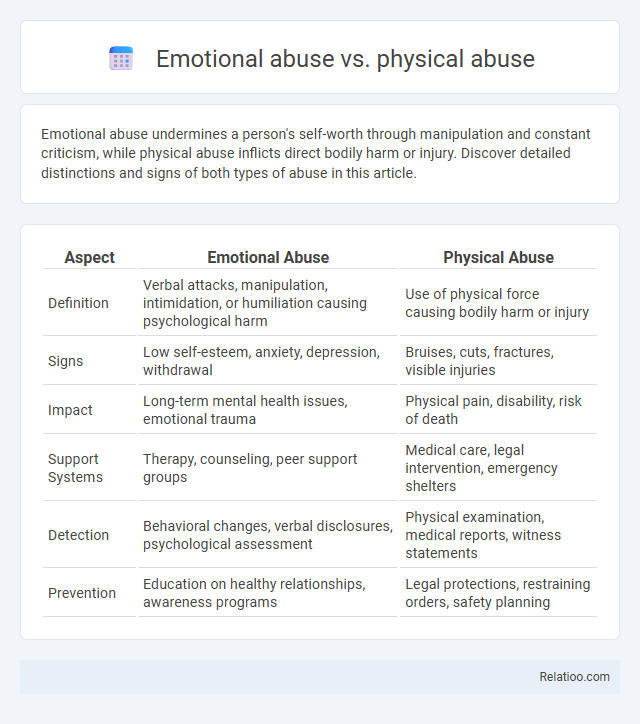Emotional abuse undermines a person's self-worth through manipulation and constant criticism, while physical abuse inflicts direct bodily harm or injury. Discover detailed distinctions and signs of both types of abuse in this article.
Table of Comparison
| Aspect | Emotional Abuse | Physical Abuse |
|---|---|---|
| Definition | Verbal attacks, manipulation, intimidation, or humiliation causing psychological harm | Use of physical force causing bodily harm or injury |
| Signs | Low self-esteem, anxiety, depression, withdrawal | Bruises, cuts, fractures, visible injuries |
| Impact | Long-term mental health issues, emotional trauma | Physical pain, disability, risk of death |
| Support Systems | Therapy, counseling, peer support groups | Medical care, legal intervention, emergency shelters |
| Detection | Behavioral changes, verbal disclosures, psychological assessment | Physical examination, medical reports, witness statements |
| Prevention | Education on healthy relationships, awareness programs | Legal protections, restraining orders, safety planning |
Understanding Emotional and Physical Abuse
Emotional abuse involves manipulative behaviors such as gaslighting, verbal insults, and controlling actions that damage Your mental well-being and self-esteem without leaving visible scars. Physical abuse includes harmful acts like hitting, slapping, or restraining, resulting in bodily injury or pain. Recognizing the differences between these types of abuse is crucial for identifying the signs and seeking appropriate support to protect Your overall health and safety.
Defining Emotional Abuse: Tactics and Signs
Emotional abuse involves patterns of behavior aimed at undermining Your self-worth through tactics such as constant criticism, manipulation, and isolation. Unlike physical abuse, which inflicts bodily harm, emotional abuse damages mental and emotional well-being, often leaving invisible scars like anxiety, depression, and chronic self-doubt. Recognizing signs like excessive jealousy, gaslighting, verbal attacks, and controlling behavior is essential for identifying and addressing this harmful form of abuse.
Recognizing Physical Abuse: Forms and Indicators
Recognizing physical abuse involves identifying signs such as unexplained bruises, burns, fractures, or frequent injuries inconsistent with explanations provided by the person involved. Unlike emotional abuse, which manifests through verbal assaults, manipulation, and psychological harm, physical abuse leaves visible marks on Your body that require urgent attention. Understanding these indicators helps differentiate between various forms of abuse and ensures timely intervention for Your safety.
The Psychological Impact of Emotional Abuse
Emotional abuse inflicts deep psychological wounds that often surpass the visible damage caused by physical abuse, leading to long-term issues such as anxiety, depression, and diminished self-worth. Unlike physical abuse, the scars from emotional abuse are internal and can distort Your ability to trust, form healthy relationships, and maintain emotional stability. Understanding the profound psychological impact of emotional abuse is essential for effective recovery and healing.
Physical Consequences of Physical Abuse
Physical abuse results in immediate and long-lasting physical consequences, including bruises, fractures, internal injuries, and chronic pain. Unlike emotional abuse, which primarily affects mental health, physical abuse directly damages bodily tissues, leading to potential disabilities and increased risk of infections. Understanding these physical consequences is crucial for accurate diagnosis and effective medical intervention.
Similarities Between Emotional and Physical Abuse
Emotional abuse and physical abuse share core characteristics, including the exertion of power and control over the victim, often resulting in long-lasting psychological trauma and diminished self-worth. Both forms of abuse can escalate over time, causing harm that is difficult to detect and equally damaging to your mental and emotional well-being. Recognizing these similarities is crucial for effective intervention and support for survivors of any abuse.
Differences in Detection and Recognition
Emotional abuse often manifests through subtle signs like low self-esteem and anxiety, making detection challenging compared to physical abuse, which involves visible injuries or marks. Physical abuse is easier to recognize due to clear physical evidence such as bruises, cuts, or broken bones, whereas emotional abuse requires careful observation of behavior patterns and psychological symptoms. Your awareness plays a crucial role in identifying emotional abuse early, as it may be hidden behind silence or manipulation, unlike the more obvious nature of physical abuse.
Long-Term Effects on Survivors
Emotional abuse undermines Your self-esteem and can lead to chronic anxiety, depression, and difficulties in forming trusting relationships, while physical abuse often results in lasting physical injuries and increased risk of PTSD. Both types of abuse contribute to long-term health problems, including chronic pain, substance dependence, and impaired brain development. Understanding the distinct yet interconnected impacts of emotional and physical abuse is crucial for effective intervention and survivor support.
Barriers to Seeking Help
Emotional abuse, physical abuse, and general abuse present distinct challenges, but all share common barriers that prevent victims from seeking help, such as fear of retaliation, shame, and lack of support systems. You may struggle to recognize emotional abuse as severely as physical abuse, which can delay intervention and access to resources. Overcoming these barriers requires awareness of the different abuse types and available support mechanisms tailored to each victim's unique experience.
Healing and Recovery: Paths Forward
Healing from emotional abuse, physical abuse, and general abuse requires recognizing the unique impact each form has on your mental and physical well-being. Emotional abuse often leaves deep psychological scars that demand therapy focused on rebuilding self-esteem and trust, while physical abuse necessitates medical care alongside psychological support to recover bodily and emotionally. Recovery paths emphasize safety, counseling, support networks, and self-care practices tailored to the distinct trauma experienced, empowering you to reclaim control and foster resilience.

Infographic: Emotional abuse vs physical abuse
 relatioo.com
relatioo.com